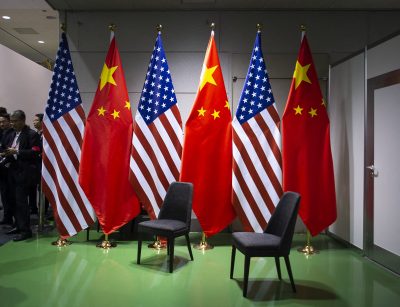China
Middle power diplomacy essential to secure Asia against big power rivalry

Author: Editorial Board, ANU
There will be no resolution of the big problems of our age without the big powers, notably the United States and China, being willing parties to their settlement. And success will depend critically on the trust that each puts in the other’s stake in the game.
On the problems of climate change and the transformation of the global energy economy and technologies that are needed to effect a reduction in man-made global warming; on arms control and limiting the spread of weapons of mass destruction; on revamping global trade and economic governance to make it fit to manage the hyper-interdependent and digitally wired economy of the 21st century: if the United States and China don’t both buy into the solutions, there will be no solutions.
Yet what is increasingly plain for all to see is that these two great powers, left to their own devices, are incapable of resolving these problems alone, without damage of consequence to the global order over which they now imperfectly have the pretension to preside.
To be sure, the two big powers account for a considerable part of the world economy and military power. Yet together they make up just over two-fifths of global production, and under a quarter of global trade, although they account for over half of global military expenditure, as the balance of economic and military power between them tilts steadily towards China.
In 1960, the United States itself generated two-fifths of global GDP and 15 per cent of global trade. The other substantial 60 per cent of global production and 75 per cent of global trade, in 2020, belonged to Europe (around 16 per cent of global GDP and 14 per cent of trade) and a range of middle powers.
If the United States had the will to lead the global economic and trading system today — and patently it does not, as first President Trump prosecuted and now President Biden is prosecuting each their own populist versions of ‘America First’ — it doesn’t have the weight or the capacity.
Certainly the three-hour conversation during the virtual summit between US President Joe Biden and Chinese President Xi Jinping last week exuded a welcome cosiness and brought a worthy initiative to talk about nuclear missiles. But on the other big issue of the economy and global governance there was a troubling, largely empty set.
Indeed, the United States and China appear to be doing their best to undermine global trade governance. The Phase One trade deal between China and the United States is not free trade, it is managed trade — China agreed to buy quotas of US commodities. In a deal done earlier this month, the European Union lifted the retaliatory tariffs on Harley Davidsons and Kentucky Bourbon from the United States in exchange for allowing quota-ed volumes of European steel and aluminium into the United States. US protectionism that ramped up under former President Trump remains and the United States is retreating without shame to the use of voluntary export restraints and managed trade of the 1980s.
As Tom Westland explains in the first of our two lead articles this week, ‘in economics as in sport, competition is best managed by neutral umpires, not by the participants themselves’. He points out that ‘it’s not clear what Xi’s and Biden’s responsibly managed competition will look like. [But if] it looks anything like the managed trade that now governs the economic interactions of the world’s two largest economies, then “competition” is a wild misnomer’.
If the middle powers, who constitute the major third force, stand by and let the United States and China carve up the world, they will surrender their national interests and international public good to a duumvirate of big power interests. As Westland points out, ‘the US-China “Phase One” trade deal, represents the worst kind of anti-competitive policy kludge, designed to protect politically favoured industries in the United States and kicking out Australian and Canadian farmers and gas suppliers who can produce more efficiently than their American counterparts’.
These big geopolitical and economic fault-lines that threaten global prosperity and security today run through East Asia’s backyard. The middle powers — Australia, Japan, South Korea and ASEAN among them — that comprise half the region alongside China now face the challenge of devising strategies that embrace their major economic partner on one side and their major security ally or partner on the other. But at the same time, they need to protect their interests and the…
Business
Gordonstoun Severs Connections with Business Led by Individual Accused of Espionage for China

Gordonstoun school severed ties with Hampton Group over espionage allegations against chairman Yang Tengbo. He denies involvement and claims to be a victim of political tensions between the UK and China.
Allegations Lead to School’s Decision
Gordonstoun School in Moray has cut ties with Hampton Group International after serious allegations surfaced regarding its chairman, Yang Tengbo, who is accused of being a spy for the Chinese government. Known by the alias "H6," Mr. Tengbo was involved in a deal that aimed to establish five new schools in China affiliated with Gordonstoun. However, the recent allegations compelled the school to terminate their agreement.
Public Denial and Legal Action
In response to the spying claims, Mr. Tengbo publicly revealed his identity, asserting that he has committed no wrongdoing. A close associate of Prince Andrew and a former Gordonstoun student himself, Mr. Tengbo has strenuously denied the accusations, stating that he is a target of the escalating tensions between the UK and China. He has claimed that his mistreatment is politically motivated.
Immigration Challenges and Legal Responses
Yang Tengbo, also known as Chris Yang, has faced additional challenges regarding his immigration status in the UK. After losing an appeal against a ban enacted last year, he reiterated his innocence, condemning media speculation while emphasizing his commitment to clear his name. Gordonstoun, on its part, stated its inability to divulge further details due to legal constraints.
Source : Gordonstoun cuts ties with business chaired by man accused of spying for China
Business
China Dismantles Prominent Uyghur Business Landmark in Xinjiang – Shia Waves

The Chinese government demolished the Rebiya Kadeer Trade Center in Xinjiang, affecting Uyghur culture and commerce, prompting criticism from activists amid concerns over cultural erasure and human rights violations.
Demolition of a Cultural Landmark
The Chinese government recently demolished the Rebiya Kadeer Trade Center in Urumqi, Xinjiang, a vital hub for Uyghur culture and commerce, as reported by VOA. This center, once inhabited by more than 800 predominantly Uyghur-owned businesses, has been deserted since 2009. Authorities forcibly ordered local business owners to vacate the premises before proceeding with the demolition, which took place without any public notice.
Condemnation from Activists
Uyghur rights activists have condemned this demolition, perceiving it as part of China’s broader strategy to undermine Uyghur identity and heritage. The event has sparked heightened international concern regarding China’s policies in Xinjiang, which have been characterized by allegations of mass detentions and cultural suppression, prompting claims of crimes against humanity.
Rebiya Kadeer’s Response
Rebiya Kadeer, the center’s namesake and a notable Uyghur rights advocate, criticized the demolition as a deliberate attempt to erase her legacy. Kadeer, who has been living in exile in the U.S. since her release from imprisonment in 2005, continues to advocate for Uyghur rights. She has expressed that her family members have suffered persecution due to her activism, while the Chinese government has yet to comment on the legal ramifications of the demolition.
Source : China Demolishes Uyghur Business Landmark in Xinjiang – Shia Waves
China
China Expands Nationwide Private Pension Scheme After Two-Year Pilot Program

China’s private pension scheme, previously piloted in 36 cities, will roll out nationwide on December 15, 2024, enabling workers to open tax-deferred accounts. The initiative aims to enhance retirement savings, address aging population challenges, and stimulate financial sector growth.
After a two-year pilot program, China has officially expanded its private pension scheme nationwide. Starting December 15, 2024, workers covered by urban employee basic pension insurance or urban-rural resident basic pension insurance across the country can participate in this supplementary pension scheme. This nationwide rollout represents a significant milestone in China’s efforts to build a comprehensive pension system, addressing the challenges of a rapidly aging population.
On December 12, 2024, the Ministry of Human Resources and Social Security, together with four other departments including the Ministry of Finance, the State Taxation Administration, the Financial Regulatory Administration, and the China Securities Regulatory Commission, announced the nationwide implementation of China’s private pension scheme effective December 15, 2024. The initiative extends eligibility to all workers enrolled in urban employee basic pension insurance or urban-rural resident basic pension insurance.
A notable development is the expansion of tax incentives for private pensions, previously limited to pilot cities, to a national scale. Participants can now enjoy these benefits across China, with government agencies collaborating to ensure seamless implementation and to encourage broad participation through these enhanced incentives.
China first introduced its private pension scheme in November 2022 as a pilot program covering 36 cities and regions, including major hubs like Beijing, Shanghai, Guangzhou, Xi’an, and Chengdu. Under the program, individuals were allowed to open tax-deferred private pension accounts, contributing up to RMB 12,000 (approximately $1,654) annually to invest in a range of retirement products such as bank deposits, mutual funds, commercial pension insurance, and wealth management products.
Read more about China’s private pension pilot program launched two years ago: China Officially Launches New Private Pension Scheme – Who Can Take Part?
The nationwide implementation underscores the Chinese government’s commitment to addressing demographic challenges and promoting economic resilience. By providing tax advantages and expanding access, the scheme aims to incentivize long-term savings and foster greater participation in personal retirement planning.
The reform is expected to catalyze growth in China’s financial and insurance sectors while offering individuals a reliable mechanism to enhance their retirement security.
| This article was first published by China Briefing , which is produced by Dezan Shira & Associates. The firm assists foreign investors throughout Asia from offices across the world, including in in China, Hong Kong, Vietnam, Singapore, and India . Readers may write to info@dezshira.com for more support. |
Read the rest of the original article.






